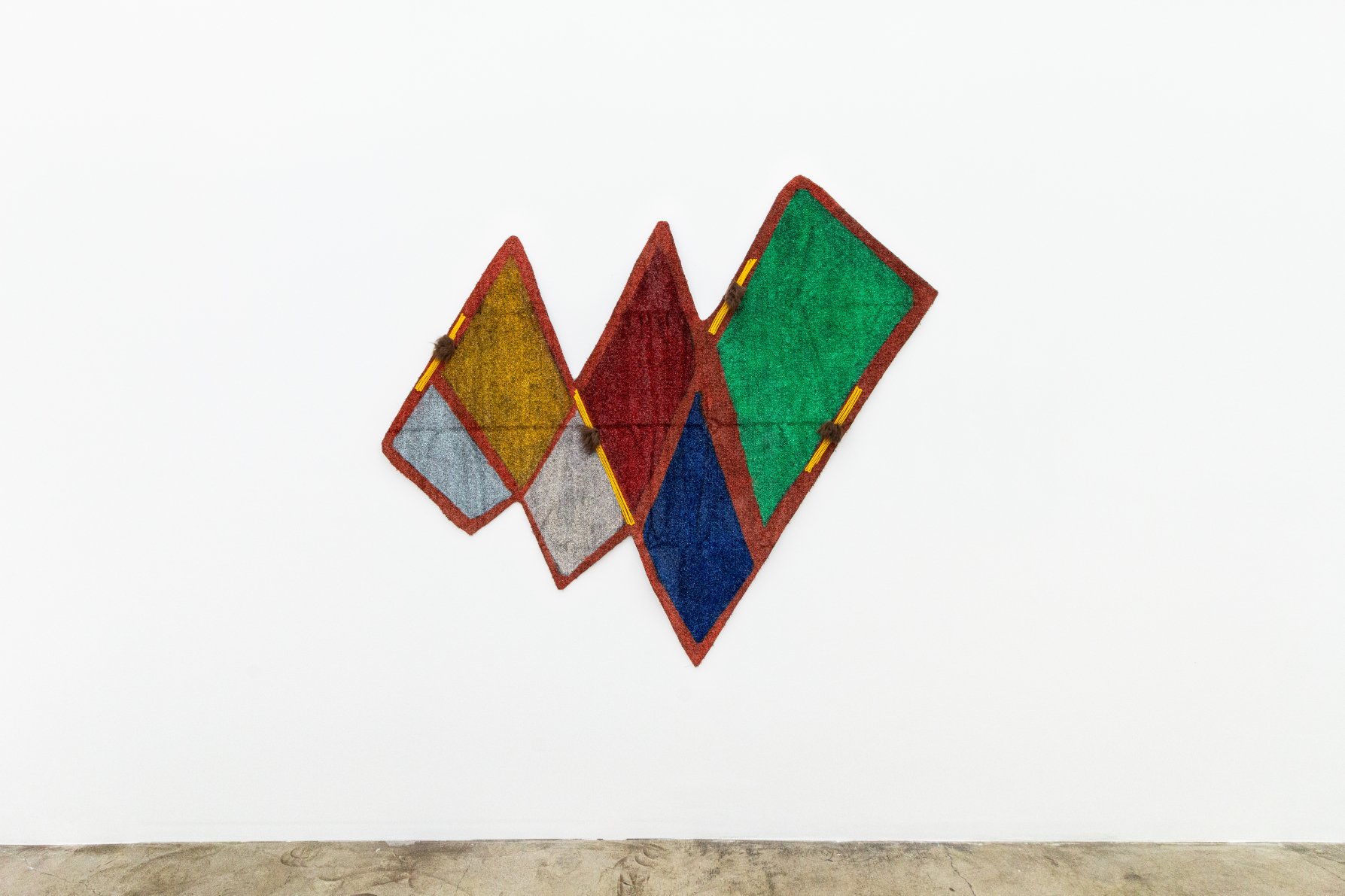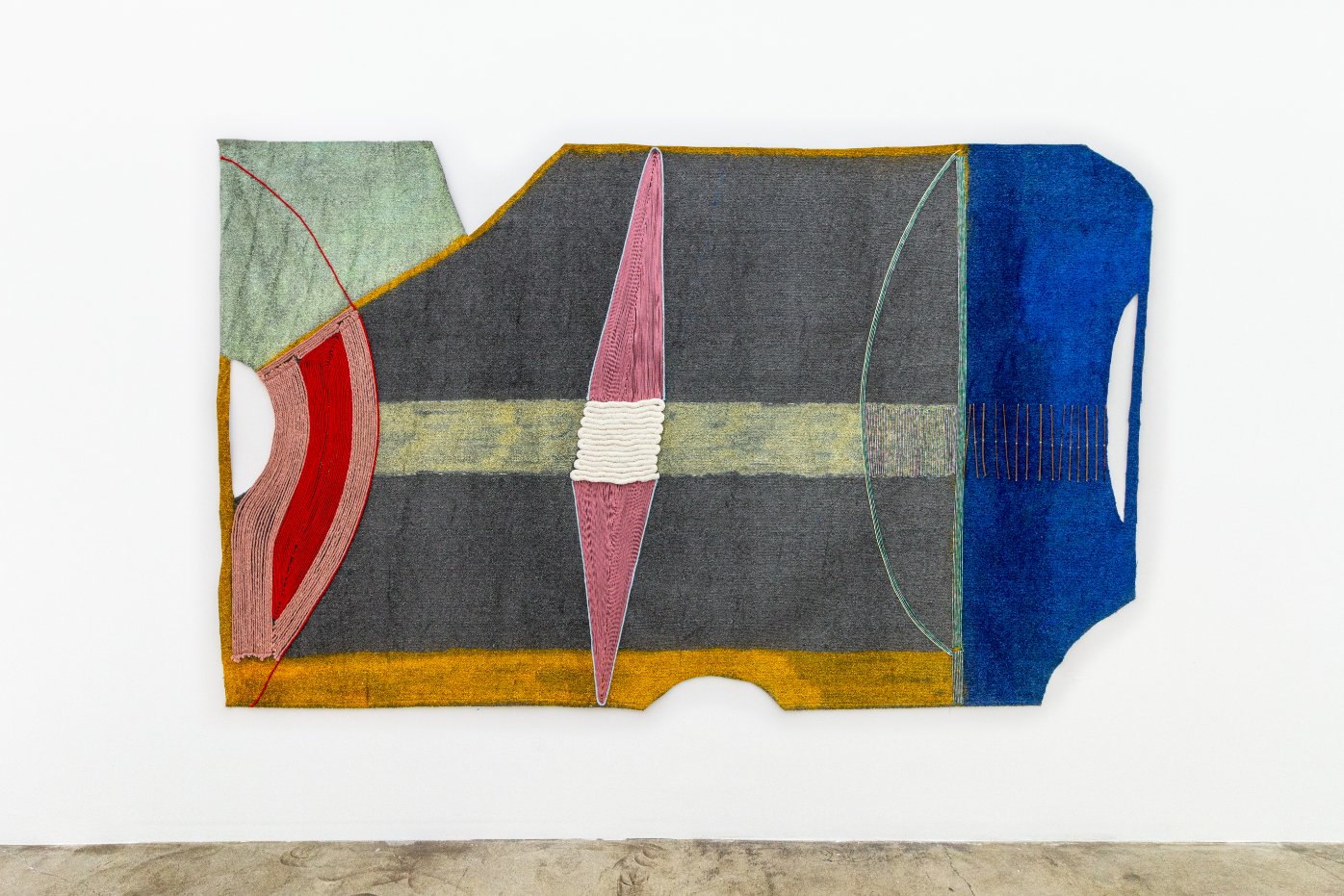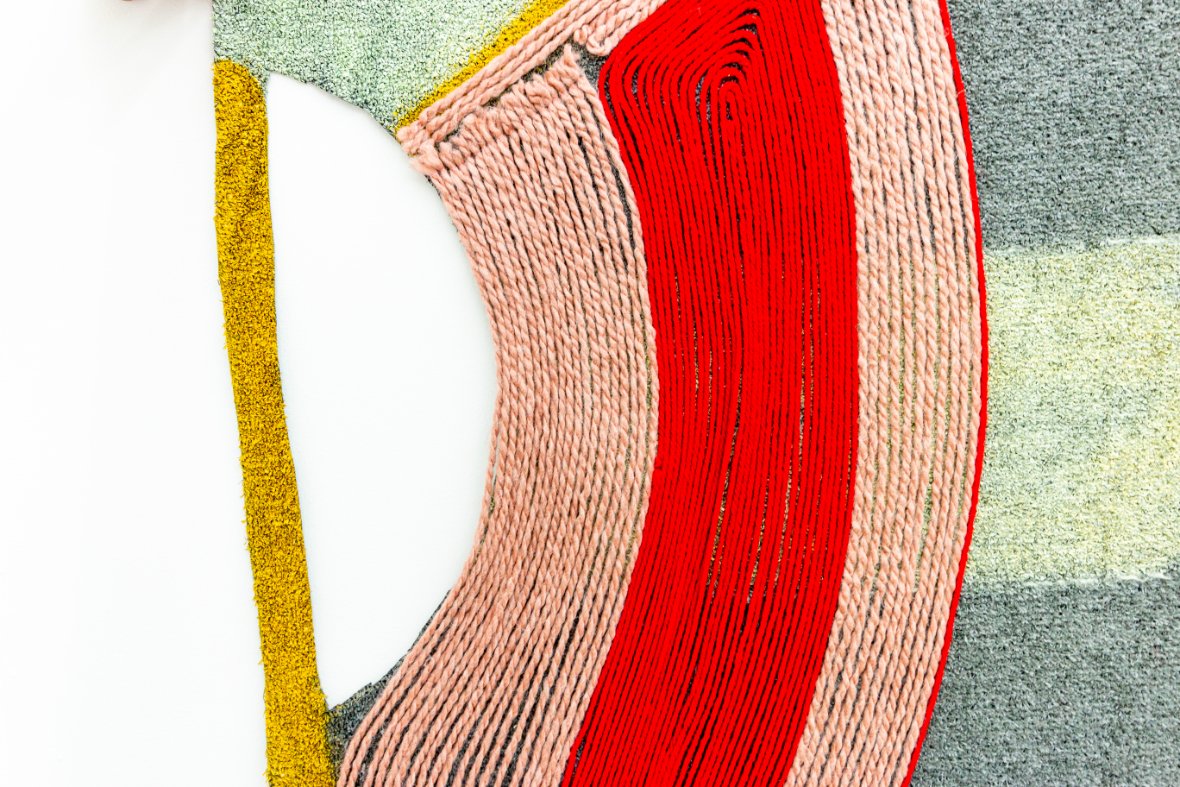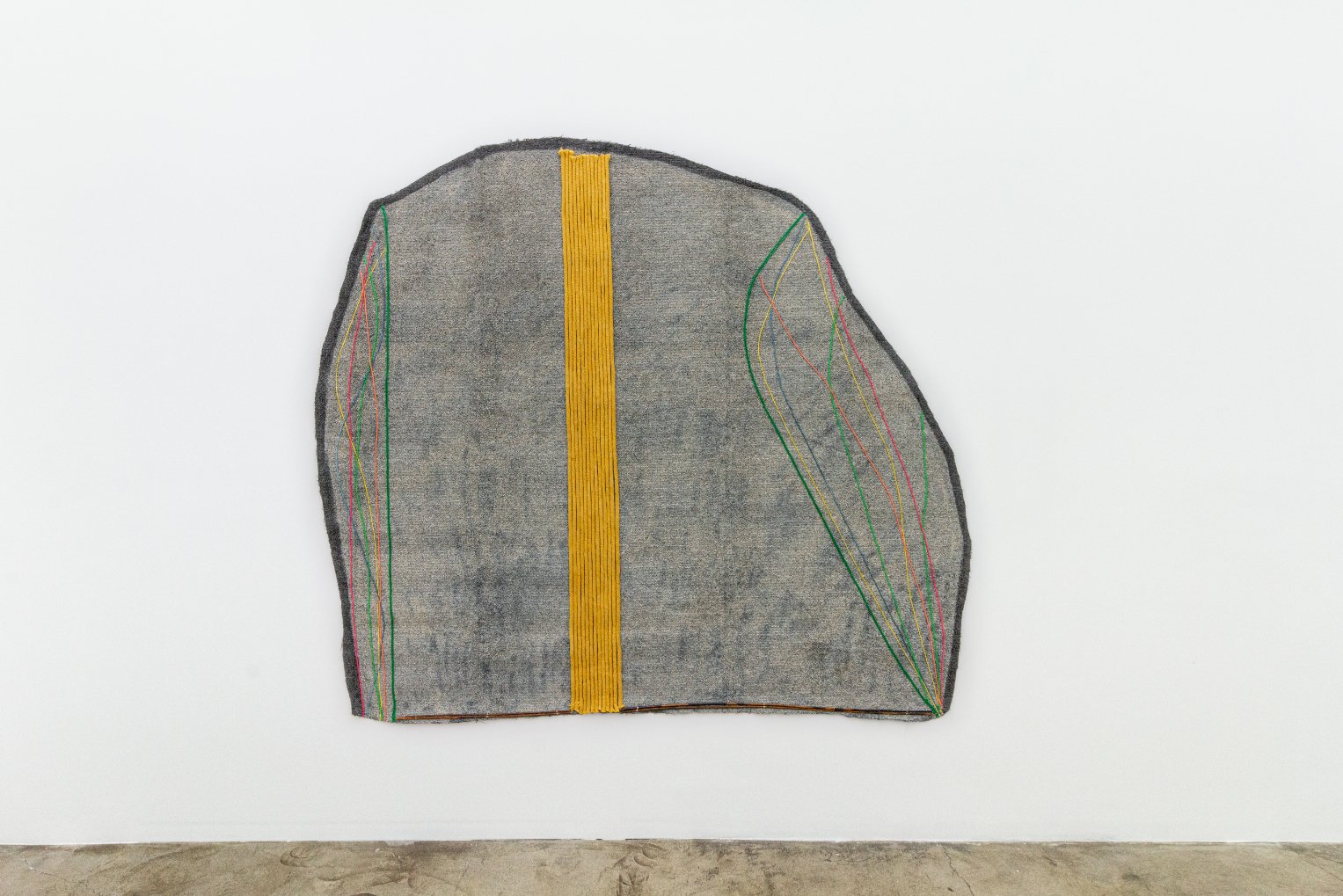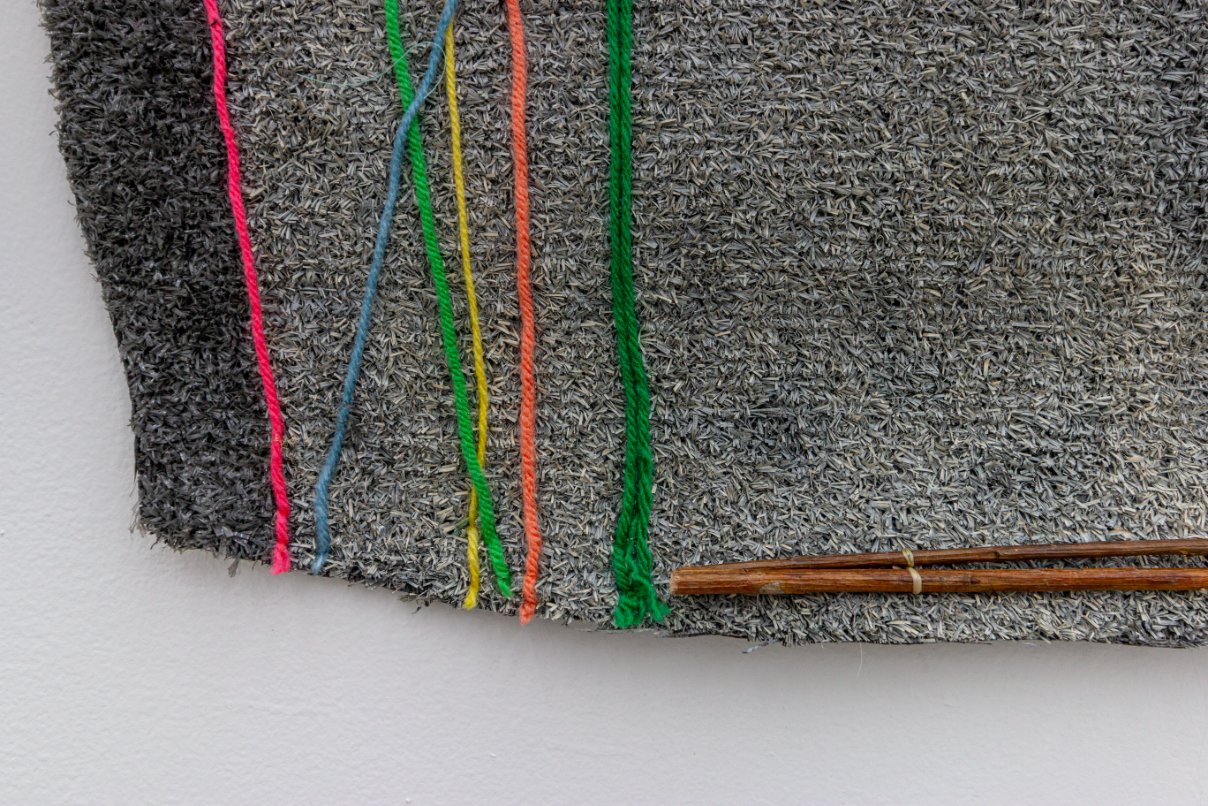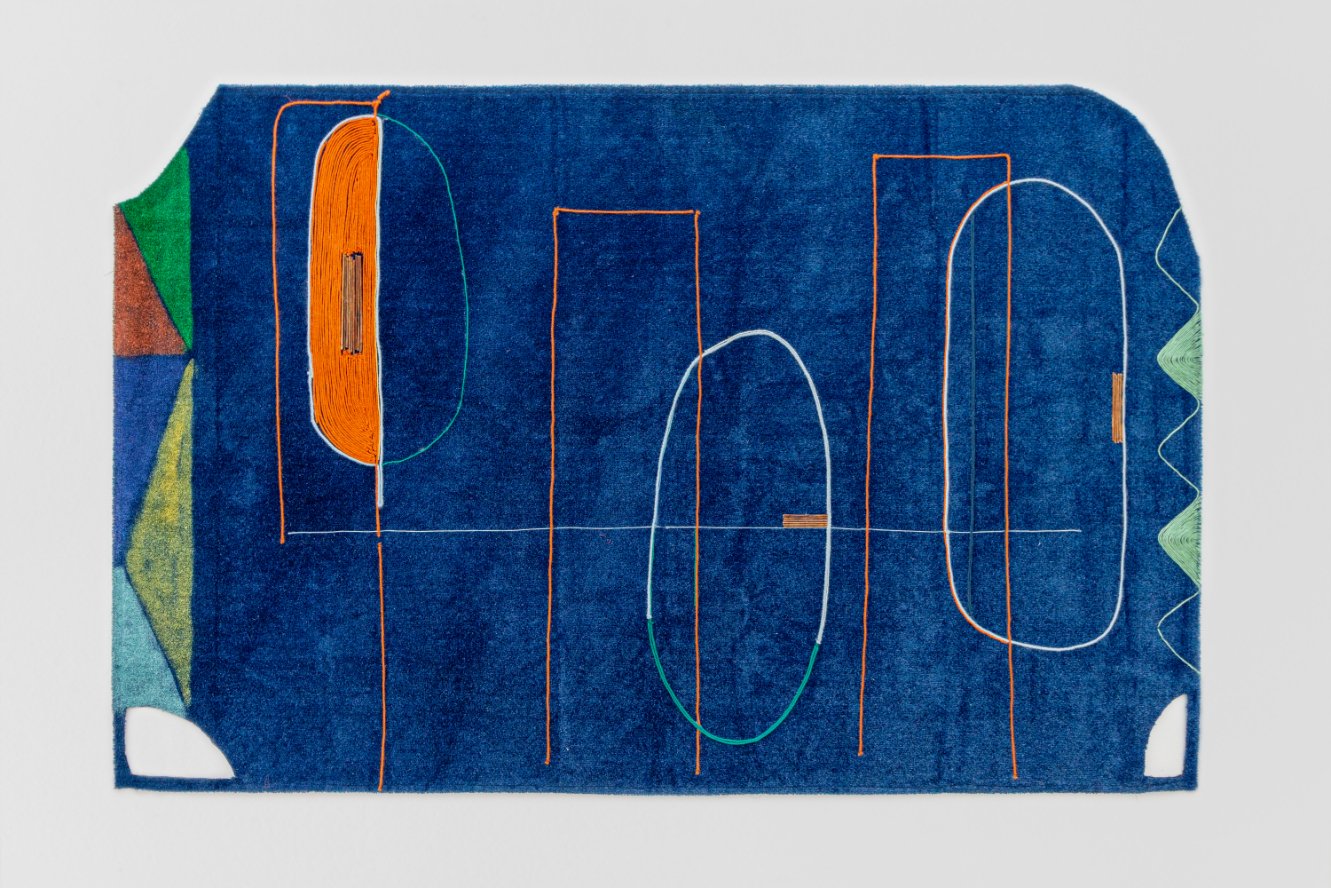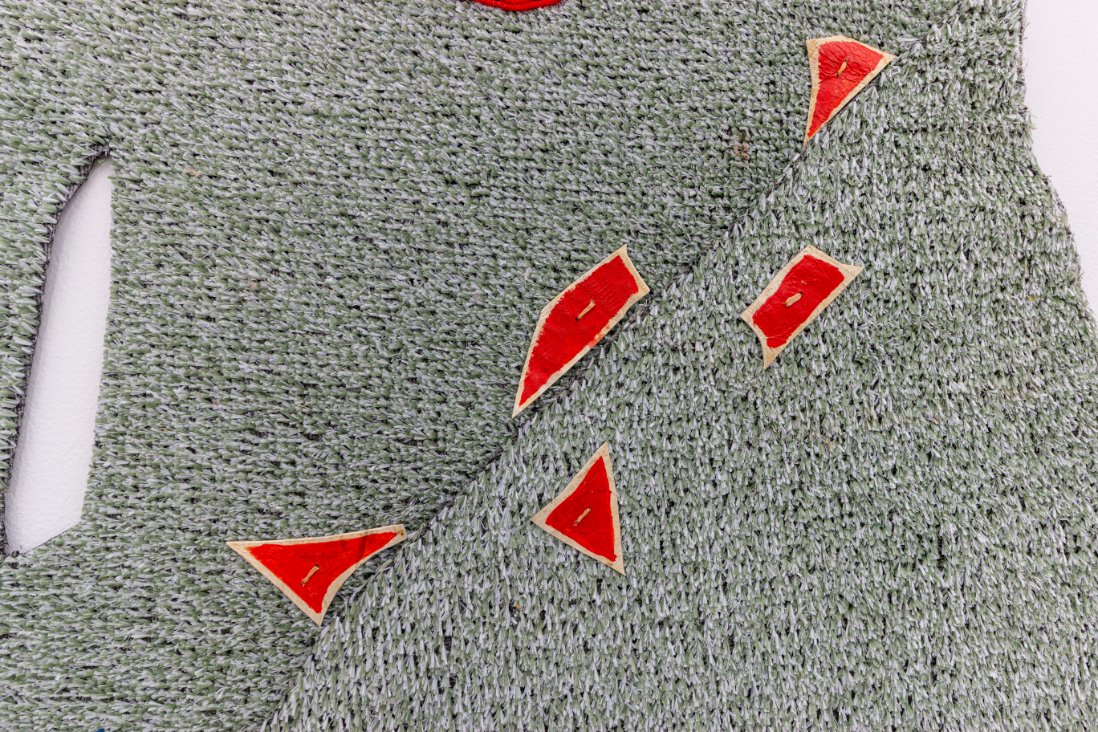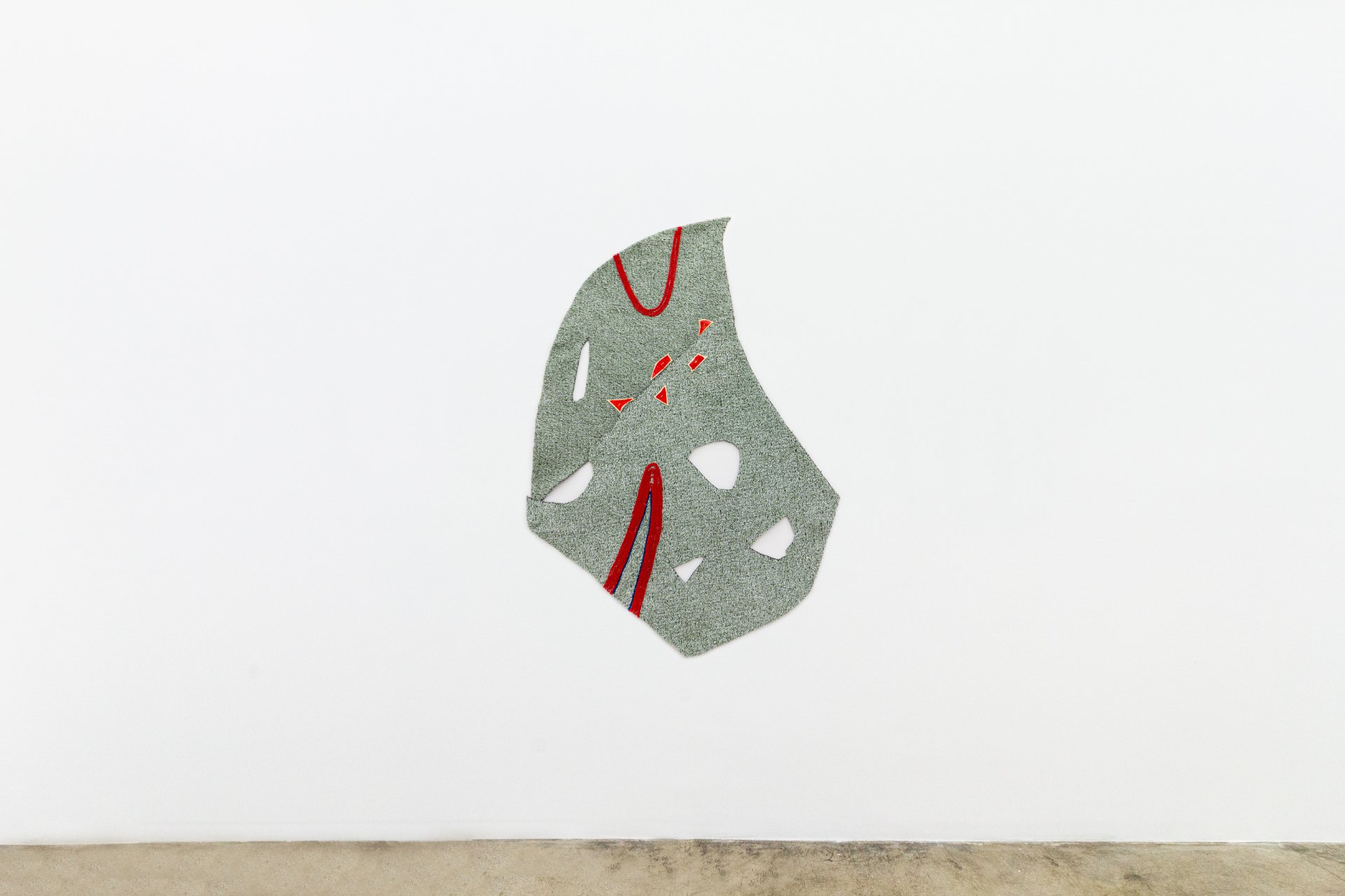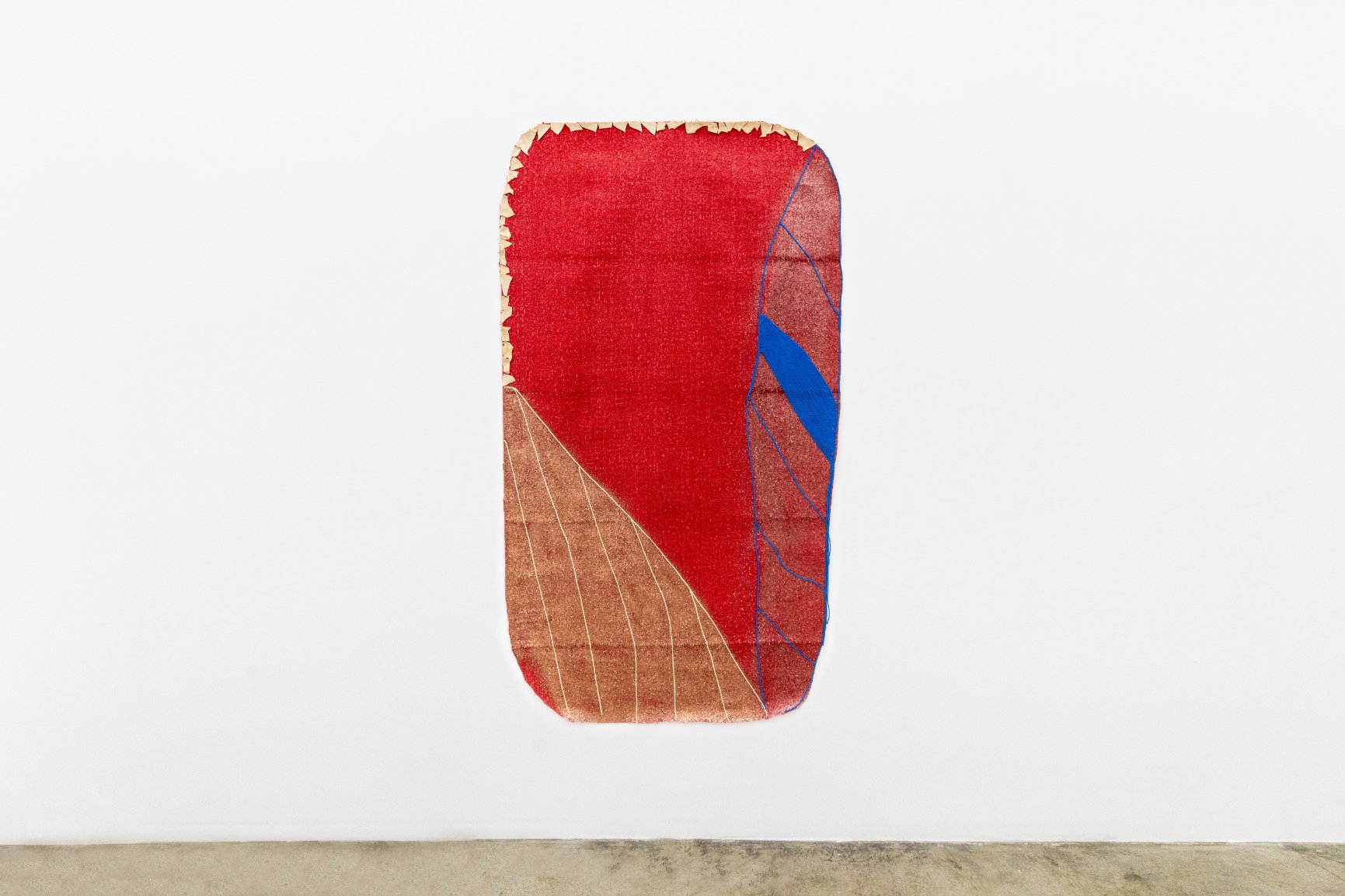Teresa Baker at Fogo Island Arts Studio, Newfoundland. Photograph by Joshua Jensen, courtesy the artist and de boer, Los Angeles.
interview by Summer Bowie
Raised nomadically along the Northern Plains of the United States, artist Teresa Baker spent her childhood shrouded in tribal storytelling. Although, it wasn’t until recently that she realized how thoroughly steeped her visual work had become in all of these inherited allegories. Working with a wide range of materials, both organic and inorganic, she weaves the fiction and nonfiction of her heritage to create works that reflect the complex nature of American tradition. Referencing artists of the abstract expressionist, cubist, and postminimalist movements in harmony with the topographical territories and utilitarian objects employed by the Indigenous nations who inform her practice, Baker imbues her works with an autonomy that allows them to be singular and timeless. In anticipation of her solo exhibition with de boer, Los Angeles at NADA Miami, I spoke with the artist about her unusual path into artmaking, the influence of her wide-reaching travels abroad, and the delicate balance of becoming a mother while the demand for her work has skyrocketed.
SUMMER BOWIE: You are from the Mandan & Hidatsa tribes of North Dakota and grew up traveling throughout the national parks of the Northern Plains. How did you come to have such an unusual childhood and how did it inform your work?
TERESA BAKER: My father worked for the National Park Service, and while he held various positions over his thirty-six years there, he held the title of Superintendent when I was growing up. He was Superintendent of Little Bighorn Battlefield, Chickasaw National Recreation Area, Corps of discovery II, and Mt. Rushmore. His mission as the first American Indian Superintendent of a National Park was to bring the Native side of the story back to the parks where he worked—through public programs as well as by making permanent changes to the exhibitions within the parks. He involved the local tribes from wherever we lived. Spending my childhood not only in nature but also in sacred and historical sites, looking at educational exhibits, and listening to storytelling—this all had a major impact on my art and myself.
BOWIE: You grew up with a lot of oral storytelling. Do you see your work as a form of storytelling?
BAKER: Only recently did I begin to see my work as a form of storytelling. For so long, I thought because my work is abstract, non-linear, non-narrative then it couldn’t be storytelling. But over the last few years, I have come to understand that my work is actually a form of storytelling on a few different levels: formally, in the way shapes, color, and textures work together to create their own language and relationships; and personally, because of my history with place and memory, and how the materials I use represent culture both traditional and contemporary.
BOWIE: When did you realize that you wanted to go to art school and what made you choose Fordham and then later California College of the Arts for your MFA?
BAKER: I had no idea I wanted to be an artist when I went to Fordham for undergrad. At the time, my biggest mission was to just get to NYC, and out of Nebraska where I went to high school. It wasn’t until I took an art class in college that something clicked. I then took advantage of an opportunity to study abroad at Gerrit Rietveld Acadamie in Amsterdam, which really solidified my interest in art. Once I returned to Fordham I changed my major to art and ended up working with incredible professors who both challenged and supported my work. After living in NYC for about four years after undergrad, I decided I needed a “proper” art school. As great as Fordham was, it was not an art school, and I wanted to take advantage of the time, facilities, and relationships that art schools offered. I also knew I did not want to stay on the east coast or apply to an east coast MFA program—so I found CCA. I was drawn to its interdisciplinary approach—an approach that resonated with my interests and practice. It ended up being a great experience and time for me and my practice.
BOWIE: You work a lot with AstroTurf, which references grass and you create shapes that reference both hides and territories. Can you talk a little bit about your use of reference?
BAKER: For a long time, I initially talked publicly only about the formal aspects of my work, but my work has always been so personal to me. The intentions I put into it have always been hopeful, sentimental, searching, and referential. I have found that even though I have an intuitive practice, at the end of the day, I am aiming to capture the place/places where I am from. The lands where I am from and the materials I use represent so much: culture, politics, environment, relationships, and spirituality.
BOWIE: Your work is very concerned with autonomy and power. How can a work be autonomous and what gives it power?
BAKER: For me, autonomy comes in the form of letting each piece find its own shape and take on its own compositional strategies that may not be directly referenced in the work that comes before or after it. While I stick to the same materials, and they all have the same feeling and certainly are related, I also have a hard time making the same shape over and over. If I do that, it starts to feel like a prescription, and the object doesn’t get to be singular. I can only hope the work has power—that’s the ultimate goal, and part of what keeps me making. I think power comes from a particular balance of maker and materials. And power for me is tied to what is visceral, non-static, and alive.
Baker Basket, 2022
Courtesy the Artist & de boer, Los Angeles
Photograph: Jacob Phillip
BOWIE: A few years ago you ventured into freestanding sculpture with your woven willow baskets. Can you talk about ‘burden baskets’ and the role they play in Hidatsa culture?
BAKER: I don’t make traditional burden baskets, but they are certainly the inspiration for the baskets I make now. Burden baskets are used in various ceremonial ways, one of which surrounds harvest, specifically corn ceremonies. Another role they play in our tribe is utilitarian—for hauling produce to and from our gardens. The Mandan and Hidatsa had villages on the upper Missouri River in what is now North Dakota, and we had vast gardens, so the burden baskets made by and used by the women were important within daily and spiritual contexts.
BOWIE: You’ve also considered exploring some of the clay pottery techniques that are traditional to your Mandan/Hidatsa culture. Is that something you’ve been working on?
BAKER: Unfortunately, I haven’t been able to investigate that yet—it’s a project that is still waiting.
BOWIE: Your work has taken you all over the United States. You went from the Great Plains to New York, Texas, and California. However, in 2007, you were awarded the Susan Lipani Travel Grant, which brought you to Berlin and more recently you finished a residency at Fogo Island. How have your experiences outside of the United States informed your practice?
BAKER: They have strengthened my attachment and commitment to home, to memory, and to understanding my ties to place and community. I love to travel and explore, but I also recognize the impact of the expanse of the Northern Plains landscape—it’s a vast, quiet, and grounding place that gives a lot. My travels have all been for different reasons, and come at different points in my life. Being in residence on Fogo Island, NL for three months last summer was incredible. The island is beautiful, and living surrounded by water is not something I am used to. At the same time, in its expansiveness and movement, the sea shares a lot in common with the prairie, so I love to be an observer of that. And I love to be an observer of a new place and see how it makes its way into my work. Because my practice is largely intuitive, sometimes I don’t see how the new places come into the work until after I am done working. Oftentimes, the places stay with me for many years.
BOWIE: You’ll be hosting a talk at NADA Miami this year to discuss how you combine modern aesthetics and materials with natural ones to create abstracted landscapes. Can you tell us how you discovered this process?
BAKER: Many years of playing with formal investigations of paint and various materials has led me to this point. I’ve delved into a variety of materials in the past ten years—like polyurethane foam, felt, wood, canvas and vinyl—always searching for the right one that would be my ground, structure, and support. I accidentally happened upon a piece of bright blue AstroTurf in Beaumont, TX while looking for other supplies, and that was the beginning of working with this unexpected material that checked all the boxes of what I was looking for, but then it also nods towards some of the larger concepts I have always been concerned with—such as land, culture, natural and artificial worlds, and fragility.
BOWIE: Can you talk about the body of work you will be presenting at your solo exhibition with de boer, Los Angeles for NADA Miami?
BAKER: There are a lot of new moments and investigations in this work, which I am excited about, such as new colors I don’t always work with, like red. I am having a little bit of an obsession with red. On Fogo Island there were a lot of deep oranges and reds in the rocks outside my studio, which led me down that color path. I was able to find a very vibrant, red artificial turf that I then had to contend with, excitingly. I loved the challenge of working with such a loud color. I also began working with a long-haired AstroTurf, which doesn’t interact with yarn in the same way as the shorter-haired version, but I began to cut into it to make marks. There are a lot of new subtleties I played around with, like AstroTurf on AstroTurf, and sewing the same piece of AstroTurf back together in different patterns, against its weave, to alter the background. I also collaborated with a furniture designer in Fogo Island, Cody Ramseyer, to make a table for the fair booth. The shape of the tabletop references a shape found in one of my works, and it’s made out of Ash, a species native to Canada.
BOWIE: Finally, your work has been making major waves in the past two years. You received the Joan Mitchell Fellowship, The Whitney just acquired a large piece, you had a solo exhibition at Scottsdale MoCA, and you have upcoming shows at Ballroom Marfa and the Nerman Museum. Has it been difficult to keep up with the demand?
BAKER: It’s really exciting, I am actually energized by it all, and happy my work gets to have a life outside the studio. The interesting and challenging timing of it is that I am also a new mother, and so everything you mention has coincided with me being pregnant and my first year of motherhood. I have had to be very intentional with my priorities, but I am really fortunate to have a supportive partner who goes all in and takes on the parenting and domestic responsibilities when needed. He values my practice and has an artistic background as well, so that has made all the difference because he understands what goes into art making.
Teresa Baker will be speaking about her practice on December 1 @ 3:30 PM @ NADA Miami where her solo exhibition with de boer, Los Angeles is on view through December 3 @ Ice Palace Studios 1400 North Miami Avenue.
Teresa Baker on Fogo Island, Newfoundland
Photograph by Joshua Jensen, courtesy the artist and de boer, Los Angeles.


